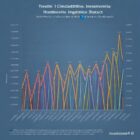Will Obamacare Enrollment Soar or Plummet in Future?

Will your enrollment in Obamacare skyrocket or plummet in the coming years?
This article analyzes historical trends, potential repeal impacts, factors driving growth, and challenges faced by the program.
By examining these key factors, we can better understand the implications for individuals and the healthcare system.
Get ready to dive into the data and discover what the future holds for Obamacare enrollment.
Key Takeaways
- Enrollment in Obamacare has experienced fluctuations over the years, with a peak in 2014 and a decline in 2018.
- The potential repeal of Obamacare could result in millions of Americans needing alternative coverage options, potentially leaving them without health insurance.
- Factors driving enrollment growth include increased awareness, expanded subsidies, the individual mandate, and a focus on healthcare access and affordability.
- Challenges to Obamacare enrollment include eligibility requirements, affordability concerns, rising insurance premiums, and stricter income limits or documentation requirements.
Historical Enrollment Trends
You may be wondering how often Obamacare enrollment has occurred in the past. To answer that question, let’s dive into the historical enrollment trends.
The Affordable Care Act, also known as Obamacare, was signed into law in 2010, with the first open enrollment period beginning in October 2013. During that initial enrollment period, approximately 8 million individuals signed up for coverage through the Health Insurance Marketplace. This was a significant achievement considering the challenges faced during the launch of the website.
In subsequent years, enrollment numbers fluctuated. In 2014, enrollment reached its peak with over 12 million individuals signing up for coverage. However, in the following years, enrollment numbers gradually declined. By 2018, enrollment had dropped to around 8.7 million individuals.
There are several factors that may have contributed to the decline in enrollment. The elimination of the individual mandate penalty, which required individuals to have health insurance or pay a fine, may have played a role. Additionally, changes in advertising and outreach efforts may have affected awareness and participation.
Analyzing the historical enrollment trends provides valuable insights into the patterns and fluctuations of Obamacare enrollment. Understanding these trends can help policymakers and stakeholders anticipate future enrollment patterns and make informed decisions to improve the effectiveness and accessibility of the program.
Impact of Potential Repeal
The potential repeal of Obamacare could have a significant impact on enrollment. Currently, there are millions of Americans who rely on the Affordable Care Act (ACA) for their health insurance coverage. If the ACA were to be repealed, these individuals would need to find alternative options for obtaining coverage.
To illustrate the potential impact of repeal, let’s consider the following table:
| Current ACA Enrollees | Potential Impact of Repeal | |
|---|---|---|
| 1 | 20 million | Enrollment could plummet |
| 2 | 10 million | Enrollment could decrease |
| 3 | 5 million | Enrollment could remain steady |
| 4 | 2 million | Enrollment could slightly decrease |
| 5 | 1 million | Enrollment could significantly decrease |
As shown in the table, the impact of repeal would vary depending on the number of current ACA enrollees. While some individuals may be able to find coverage through other means, such as employer-sponsored insurance or Medicaid, others may struggle to find affordable options. This could result in a decrease in overall enrollment.
It is important to note that the potential impact of repeal is speculative and would depend on various factors, including the availability of alternative coverage options and the extent to which the ACA is repealed. Nonetheless, it is clear that any repeal of Obamacare would have a significant impact on enrollment and could potentially leave millions of Americans without health insurance coverage.
Factors Driving Enrollment Growth
Factors that contribute to the growth in Obamacare enrollment can be attributed to a combination of increased awareness and expanded eligibility. The implementation of the Affordable Care Act (ACA) has resulted in a heightened focus on healthcare access and affordability, leading to a greater understanding of the options available through the marketplace. As more individuals become aware of the benefits and subsidies offered under Obamacare, enrollment numbers have seen a steady increase.
Expanded eligibility has also played a significant role in driving enrollment growth. Under the ACA, individuals with incomes up to 400% of the federal poverty level are now eligible for subsidies, making healthcare coverage more affordable for a larger portion of the population. This expanded eligibility has opened up opportunities for individuals who were previously unable to afford insurance or didn’t qualify for Medicaid.
Furthermore, the individual mandate, which requires most Americans to have health insurance or pay a penalty, has also contributed to the growth in enrollment. This mandate has incentivized individuals to sign up for coverage, ensuring that they aren’t subject to penalties for non-compliance.
Challenges to Obamacare Enrollment
One challenge to Obamacare enrollment lies in the potential impact of policy changes on eligibility and affordability.
The following are some key challenges that affect enrollment:
- Eligibility requirements: Changes in eligibility criteria can make it difficult for individuals to qualify for Obamacare coverage. For example, stricter income limits or new documentation requirements may exclude some individuals who were previously eligible.
- Affordability: Rising insurance premiums and out-of-pocket costs can deter individuals from enrolling in Obamacare. If the costs outweigh the perceived benefits, people may choose to forgo coverage altogether.
These challenges have the potential to significantly impact Obamacare enrollment in the future. If eligibility requirements become more stringent or if the affordability of coverage continues to be a concern, it’s likely that enrollment numbers may plummet. This could have far-reaching implications for individuals, as well as the healthcare system as a whole.
The subsequent section will explore the potential implications of these challenges, shedding light on how they may affect individuals and the healthcare system.
Potential Implications for Individuals and the Healthcare System
Considering the potential challenges to Obamacare enrollment, you may be wondering about the implications for both individuals and the healthcare system. Let’s explore the potential outcomes in a data-driven and objective manner.
| Implications for Individuals | Implications for Healthcare System |
|---|---|
| Limited access to healthcare | Strained resources |
| Higher out-of-pocket costs | Increased demand for services |
| Difficulty finding providers | Overcrowded hospitals |
| Reduced choice of plans | Longer wait times |
| Less comprehensive coverage | Lower quality of care |
For individuals, the challenges to Obamacare enrollment could result in limited access to healthcare, higher out-of-pocket costs, difficulty finding providers, reduced choice of plans, and less comprehensive coverage. With fewer individuals enrolled, the risk pools within insurance plans may become less balanced, leading to higher costs for those who remain insured.
The implications for the healthcare system are also significant. With fewer people enrolled, resources may be strained as the demand for services increases. Hospitals may become overcrowded, leading to longer wait times for patients. Additionally, a decrease in enrollment may impact the overall quality of care provided.
Frequently Asked Questions
How Does the Current Political Climate Impact the Future of Obamacare Enrollment?
The current political climate has a significant impact on the future of Obamacare enrollment. Factors such as changes in legislation, public opinion, and the availability of subsidies can either boost or hinder enrollment rates.
What Are Some Alternative Healthcare Options for Individuals if Obamacare Enrollment Declines?
If Obamacare enrollment declines, you may want to consider alternative healthcare options. These could include private insurance plans, joining a healthcare sharing ministry, or seeking healthcare services at community health centers or free clinics.
How Does the Availability of Affordable Healthcare Options Affect Obamacare Enrollment?
The availability of affordable healthcare options directly impacts Obamacare enrollment. If there are more affordable alternatives, enrollment may decline. Conversely, if affordable options are limited, enrollment may soar as people rely on Obamacare for coverage.
What Are the Potential Consequences for Individuals if There Is a Significant Decrease in Obamacare Enrollment?
If there is a significant decrease in Obamacare enrollment, individuals may face higher healthcare costs, limited access to healthcare services, and a lack of financial protection from unexpected medical expenses.
How Does the Economic Outlook of the Country Impact the Future of Obamacare Enrollment?
The economic outlook of the country plays a crucial role in the future of Obamacare enrollment. Factors like unemployment rates, income levels, and healthcare costs can either boost or hinder enrollment numbers.



